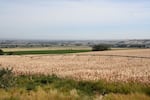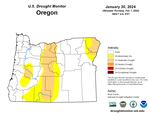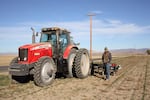
Last year, Oregon had one of the strongest snowpack's in over three decades and that, paired with recent rains, has brought much of the state to moderate or no drought conditions at all. For some central Oregon farmers, however, it will take several years to recover from a yearslong drought.
Tracy Robillard / Oregon NRCS
Drought across Oregon is easing up. That’s good news for Central Oregon farmers who’ve had to scale back as a result of low water reserves. However, it’ll take more than one good year to recover from a years-long drought.
A year ago, parts of Central Oregon were under extreme drought conditions, while an area in Crook County was under exceptional drought — the highest category assigned by the U.S. Drought Monitor — and over 80% of the state was under abnormally dry conditions.
Now, the drought monitor shows 32% of the state is abnormally dry and 16% is in moderate drought conditions. No area in the state is under extreme or exceptional drought. The low levels put Oregon at the most drought-free it’s been since 2019.

The U.S. Drought Monitor shows 32% of the state is abnormally dry and 16% is in moderate drought conditions.
U.S. Drought Monitor
By several measures, the last four years were among the worst in Oregon’s recorded history going back to the late 1800s, said Larry O’Neill, state climatologist.
“That drought was driven by a variety of things, but the biggest thing, obviously, is a lack of precipitation,” O’Neill said. “But also there are other things, too, like a lack of snowpack and also much warmer temperatures than normal.”
Irrigation districts that rely on the Deschutes River for water have had to curtail water allotments. One of them, the North Unit Irrigation District in Jefferson County — an area that produces specialty seed crops, hay and cattle — has had to limit water allotments by more than half for the last four years.
As a result, farmers there have had to cut back on the number of crops they sow in their fields and cattle ranchers have had to buy more grain or hay feed because they can’t water their own pastures, while some farmers have contemplated leaving the industry altogether according to a report from the Bulletin newspaper in Bend.
Jeremy Symon, who runs the Symon Beef Company in Madras with his wife, Johanna, said they usually have about 5,000 beef cows through the summer, though they’ve had to cut the herd back by over 40%.
“Our rangeland won’t hold nearly what we used to be able to do, so we’ve scaled it all back,” Symons said.
Last year, Oregon had one of the strongest snowpacks in over three decades and that, paired with recent rains, has brought much of the state to moderate or no drought conditions at all.
One good season is not enough, said Josh Bailey, the general manager for the North Unit Irrigation District.
He said recent rains and stronger snowpack help, though reservoirs like Crane Prairie and Wickiup — which the Deschutes River feeds — still aren’t full.

A file photo of farmer Phil Fine, who relies on water out of Wickiup Reservoir to irrigate his fields every summer.
Amanda Peacher / OPB
“It means we’re slowly getting out,” Bailey said. “But the problem is the way the watershed works on the Deschutes side. You need multiple good winters to recharge that system in order to get us back up where we’d like to be.”
Even with easing drought, Matt Cyrus, the Deschutes County Farm Bureau president, said agricultural producers will likely be short on water because of the Deschutes Basin Habitat Conservation Plan — a plan designed to protect the threatened Oregon spotted frog.
“The agreements that came out of that are forcing the irrigation districts to dump their stored water during the winter months instead of saving it and giving it to the farmers,” Cyrus said.
O’Neill said there’s still a lot of uncertainty. He said areas in central and southern Oregon are still below average on rainfall this year. He added that snowpack in the Cascade Mountains has also been erratic this year.
“Our snowpack is now trending quite a bit below normal and we’re less than halfway to where it needs to be at its peak at or near the end of March or April,” O’Neill said. “And so the forecast right now for February and March actually looks kind of dire.”
For now, Symons said, the reservoirs do look better than they did last year. He said he hopes this year he’ll be able to receive more water when the irrigation district begins releasing it in April.
“We’ll just see what it looks like in April and then we can make more plans accordingly,” Symons said. “I’ve got some fields that are still just sitting idle and not doing anything with them. But if things change come April and it looks like we have some more water, then I’ll do some spring planning of some sort, but that’s about all a guy can do.”



